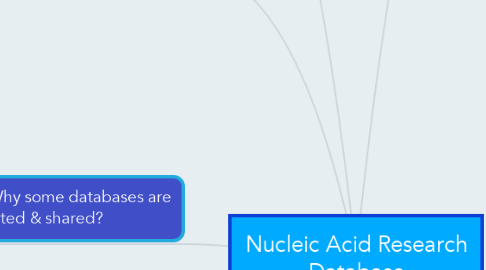
1. References
1.1. Rigden, D. J., Fernández-Suárez, X. M., & Galperin, M. Y. (2016). The 2016 database issue of Nucleic Acids Research and an updated molecular biology database collection. Nucleic acids research, 44(D1), D1-D6.
1.2. Brazas, M. D., Yim, D., Yeung, W., & Ouellette, B. F. (2012). A decade of web server updates at the bioinformatics links directory: 2003–2012. Nucleic acids research, gks632.
1.3. Bolser, D. M., Chibon, P. Y., Palopoli, N., Gong, S., Jacob, D., Del Angel, V. D., ... & Hwang, S. (2012). MetaBase—the wiki-database of biological databases. Nucleic acids research, 40(D1), D1250-D1254.
2. 5. Why some databases are no longer present & dropped?
2.1. Replaced by better & more advanced databases
2.2. Outdated & non-responsive
2.3. Merged & integrated into larger projects
2.4. Commercialized & no longer provides free access
3. 6. Why some databases are created & shared?
3.1. Enabling scientists to access invaluable information from multiple sources
3.2. Convinient
3.2.1. Digitalized & accessable online
3.2.2. Easier to update old data & keep up-to-date with new data
3.2.3. Effortless storage, searching & retrieval capacity
3.3. Allows for interaction & collaboration between scientists
4. 2. Number of databases available
4.1. 1685 databases (15 categories, 41 subcategories
4.1.1. 88 new online database resources
4.1.2. 23 removed obsolete websites
5. 3. Criteria for selection into NAR databases
5.1. Authentic database
5.2. Open and easy access
5.3. Not involve with plagiarism
5.4. Systematically organized and precise
5.5. Provide users with appropriate data and information
6. 4. Why we need to group these databases?
6.1. To make the searching process become uncomplicated
6.2. To update information and description of databases
6.3. To simplify the possible information that users need
7. Group 3
7.1. 1. Mohamed Redzuan bin Abbas 2. Ahmad Ardani Alili bin Hj Mohamed 3. Muhammad Syafiq bin Mohamed 4. Abdul Salam bin Adnan 5. Muhammad Luqman bin Selahuddeen
8. 1. Organisation of databases and its major groupings
8.1. Organisation of databases
8.1.1. Swiss Institute for Bioinformatics (SIB)
8.1.2. European Bioinformatics Institute (EMBL-EBI)
8.1.3. U.S. National Center for Biotechnology Information (NCBI)
8.2. Major Groupings
8.2.1. 2016 Nucleic Acids Research Database
8.2.1.1. 1. Nucleic acid sequence and structure 2. Protein sequence and structure 3. Metabolic and signaling pathway 4. Viruses, bacteria, protozoa and fungi 5. Genome of human and model organisms 6. Human diseases and drugs 7. Plants 8. Mitochondrial databases and databases of chemical compounds
8.2.2. NAR Online Molecular Biology Database Collection
8.2.2.1. 1. Nucleotide Sequence Databases 2. RNA sequence databases 3. Protein sequence databases 4. Structure Databases 5. Genomics Databases (non-vertebrate) 6. Metabolic and Signaling Pathways 7. Human and other Vertebrate Genomes 8. Human Genes and Diseases 9. Microarray Data and other Gene Expression Databases 10. Proteomics Resources 11. Other Molecular Biology Databases 12. Organelle databases 13. Plant databases 14. Immunological databases 15. Cell biology 16. Other
